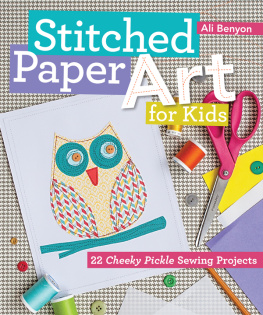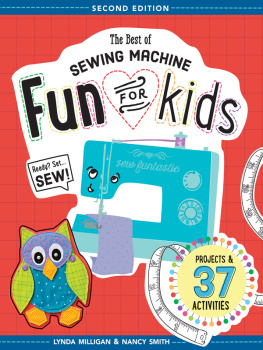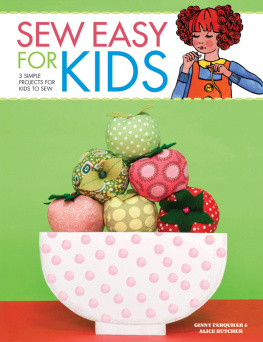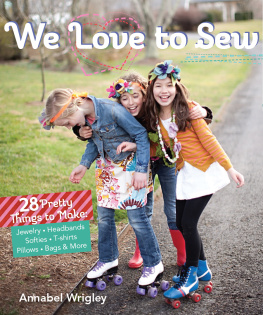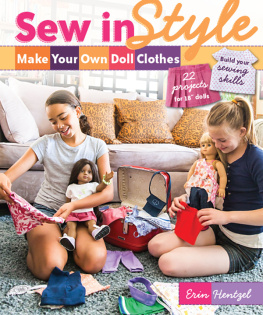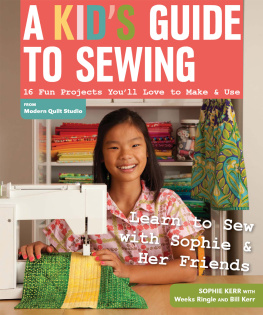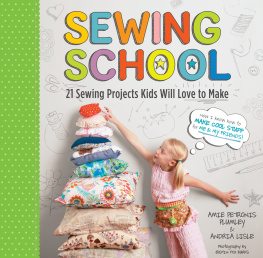Publisher: Amy Marson
Creative Director: Gailen Runge
Art Director / Cover Designer: Kristy Zacharias
Editor: S. Michele Fry
Technical Editors: Sadhana Wray and Gailen Runge
Cover/Book Designer: April Mostek
Production Coordinators: Jessica Jenkins and Zinnia Heinzmann
Production Editor: Joanna Burgarino
Illustrator: Jessica Jenkins
Photo Assistant: Mary Peyton Peppo
Subject Photography by Diane Pedersen of C&T Publishing, Inc., unless otherwise noted; Style Photography by Wes Stitt; How-to Photography by Wendi Gratz
Published by FunStitch, an imprint of C&T Publishing, Inc., P.O. Box 1456, Lafayette, CA 94549

DEDICATION
For Jo
ACKNOWLEDGMENTS
Many thanks to all the kids Ive sewn with over the yearsespecially the kids who sewed projects for this book! Alicia, Ben, Caeley, Evelyn, Haley, Hana, Ivy, Izzy, Josie, Liam, Lillian, SeAnna, Sharon, and Sophia, you all were so much fun to work with! An extra-special thanks goes to my daughter, Jo, who made every single project in the book (sometimes more than once). She helped me get everything just right. Jo, youre the best daughter ever. :-)
about this book
Are you ready to learn to sew softies? I hope youll jump in and have fun! Ive arranged the book so you can do it even if youve never used a sewing machine or threaded a needle before. Just start at the beginning, where youll learn the basics of how to sew a straight line, turn corners, and stuff your softie. Keep going chapter by chapter through all the projects in the book. Each project builds on skills you learned in previous chapters. By the end of the book, youll sew like a pro and even design your own patterns.
Along the way, I make suggestions for how you can alter patterns to make them your own. You can also go back and revise projects that you did earlier in the book but apply your new skills. Dont let my ideas stop you from trying your own! Sewing softies is fun, and I want you to play! Mix and match fabrics; redraw faces; and, after you get more experienced, even change the shape of some of the pattern pieces. The worst thing that can happen is that youll make something that looks weird and you wont like it. So start over! No big deal! Ive done it many times myself. But sometimes I end up with something thats weird in an awesomely unexpected way, and I like it! Youll never know until you try. So try!
Nowhave fun!
1.
getting started

Words to Know
EMBROIDER: To create designs using thread and special stitches. There are needles and threads designed especially for embroidery.
IRONING: To move an iron back and forth over fabric. You iron to get the wrinkles out of your clothes or to get fabric ready for cutting. However, mostly Ill be asking you to press something, rather than iron it.
PRESSING: To press an iron down on the fabric and then lift it without sliding the iron back and forth. A small craft iron can be handy for reaching small areas.
RIGHT SIDE: The design side of the fabric or the front of the fabric. Sometimes a fabric will have no distinct right or wrong side, so the project maker gets to decide. But pay attention, because you dont want to sew two left feetor maybe you do!
SEAM: The line of stitching that joins two pieces of fabric.
SEAM ALLOWANCE: The fabric between the line of stitching and the fabric edge. The seam allowance is or for patterns in this book.
WOVEN FABRIC: Fabric made from lengthwise threads linked with crosswise threads. Its not stretchy, which makes it easier for beginners to work with.
KNIT FABRIC: Fabric created using rows of loops (just like knitting by hand, but tiny). It stretches like crazy.
pattern pieces
I recommend gluing all your patterns to cardboard. The cardboard used for cereal boxes is just right. Cardboard is super easy to trace around and stands up better to repeated use. I hope youll want to make several versions of some of these creatures! Trace or photocopy the patterns from the book, glue them to the cardboard with a gluestick, and then cut them out. Keep pattern pieces tucked into labeled envelopes (one for each project) to keep them from getting lostespecially the small ones.
To use the pattern piece templates, I like to trace around them with a fabric marker or pencil. Then I remove the template and cut out the pattern along the lines. Its much easier than trying to cut the fabric while holding the pattern piece in place.
fabric
When youre shopping for fabric, look for woven or quilting cotton. Woven fabric is not stretchy. Thats important! There are tons of colors and patterns to choose from. Woven fabrics are very easy for beginners to work with. As you get more experienced, you can use fancy fabrics, such as fleece and fur. Ill introduce them in later chapters.
Always iron your fabric before you try to cut it. Its hard to accurately cut and sew wrinkly fabric. Dial the irons heat setting to cotton, and use steam.
Many projects in the book call for yard of fabric. If you go to the fabric store and buy yard of fabric, theyll cut 9 off a bolt. So youll have fabric that is 9 long and about 40 wide, which is fine. But if you shop online or at a quilt shop, youll see lots and lots of fat quarters already cut for you. These are also yard, but with different dimensions. A fat quarter is made from a half yard of fabric, cut in half again the short way. You get an almost-square piece of fabric, roughly 18 20. The proportions are often easier to work with, so choose this option whenever you can.

Woven fabrics are very easy for beginners to work with.
tools
Here are the tools youll need for almost every project in the book. Most of these tools are available at craft or sewing stores.
Why Sewing Machines Need Bobbins
Of course, you dont need to know exactly how a sewing machine works, but it helps to know the basics.
One big difference between sewing by hand and sewing by machine is that machines need two threads. When you sew by hand, the needle guides the thread from one side of the fabric to the other. In a sewing machine, there are two threads. The top thread goes through the needle and is looped with the bottom thread. The bottom thread comes from the bobbin, the small spool that goes in the area under the needle plate.
So every time the machine needle goes down and comes up, a lock stitch is created using the bobbin thread. In fact, if you use different color threads for the top and bottom, or if you look between the fabric layers (gently!), you can see the loops.

SEWING MACHINE
You can sew any of these projects entirely by hand, but most kids would rather use a sewing machine. If you dont already have a sewing machine at home, heres what to look for when youre out shopping:
Get a real sewing machinenot a toy. You can find them at fabric stores, some department stores, and, of course, sewing machine stores. Many people sell their used sewing machines online. You will not find a good machine at a toy store.
Get a basic machine.
Next page


